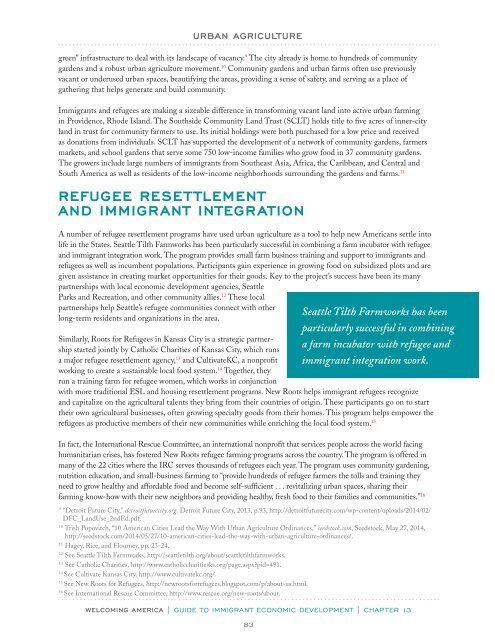IMMIGRANT
npjjbma
npjjbma
- No tags were found...
Create successful ePaper yourself
Turn your PDF publications into a flip-book with our unique Google optimized e-Paper software.
URBAN AGRICULTUREgreen” infrastructure to deal with its landscape of vacancy. 9 The city already is home to hundreds of communitygardens and a robust urban agriculture movement. 10 Community gardens and urban farms often use previouslyvacant or underused urban spaces, beautifying the areas, providing a sense of safety, and serving as a place ofgathering that helps generate and build community.Immigrants and refugees are making a sizeable difference in transforming vacant land into active urban farmingin Providence, Rhode Island. The Southside Community Land Trust (SCLT) holds title to five acres of inner-cityland in trust for community farmers to use. Its initial holdings were both purchased for a low price and receivedas donations from individuals. SCLT has supported the development of a network of community gardens, farmersmarkets, and school gardens that serve some 750 low-income families who grow food in 37 community gardens.The growers include large numbers of immigrants from Southeast Asia, Africa, the Caribbean, and Central andSouth America as well as residents of the low-income neighborhoods surrounding the gardens and farms. 11Refugee Resettlementand Immigrant IntegrationA number of refugee resettlement programs have used urban agriculture as a tool to help new Americans settle intolife in the States. Seattle Tilth Farmworks has been particularly successful in combining a farm incubator with refugeeand immigrant integration work. The program provides small farm business training and support to immigrants andrefugees as well as incumbent populations. Participants gain experience in growing food on subsidized plots and aregiven assistance in creating market opportunities for their goods. Key to the project’s success have been its manypartnerships with local economic development agencies, SeattleParks and Recreation, and other community allies. 12 These localpartnerships help Seattle’s refugee communities connect with otherlong-term residents and organizations in the area.WELCOMING AMERICA | GUIDE TO <strong>IMMIGRANT</strong> ECONOMIC DEVELOPMENT | CHAPTER 13.83.Seattle Tilth Farmworks has beenparticularly successful in combininga farm incubator with refugee andimmigrant integration work.Similarly, Roots for Refugees in Kansas City is a strategic partnershipstarted jointly by Catholic Charities of Kansas City, which runsa major refugee resettlement agency, 13 and CultivateKC, a nonprofitworking to create a sustainable local food system. 14 Together, theyrun a training farm for refugee women, which works in conjunctionwith more traditional ESL and housing resettlement programs. New Roots helps immigrant refugees recognizeand capitalize on the agricultural talents they bring from their countries of origin. These participants go on to starttheir own agricultural businesses, often growing specialty goods from their homes. This program helps empower therefugees as productive members of their new communities while enriching the local food system. 15In fact, the International Rescue Committee, an international nonprofit that services people across the world facinghumanitarian crises, has fostered New Roots refugee farming programs across the country. The program is offered inmany of the 22 cities where the IRC serves thousands of refugees each year. The program uses community gardening,nutrition education, and small-business farming to “provide hundreds of refugee farmers the tolls and training theyneed to grow healthy and affordable food and become self-sufficient . . . revitalizing urban spaces, sharing theirfarming know-how with their new neighbors and providing healthy, fresh food to their families and communities.” 169 “Detroit Future City,” detroitfuturecity.org. Detroit Future City, 2013, p.93, http://detroitfuturecity.com/wp-content/uploads/2014/02/DFC_LandUse_2ndEd.pdf.10 Trish Popovitch, “10 American Cities Lead the Way With Urban Agriculture Ordinances,” seedstock.com, Seedstock, May 27, 2014,http://seedstock.com/2014/05/27/10-american-cities-lead-the-way-with-urban-agriculture-ordinances/.11 Hagey, Rice, and Flourney, pp. 23-24.12 See Seattle Tilth Farmworks, http://seattletilth.org/about/seattletilthfarmworks.13 See Catholic Charities, http://www.catholiccharitiesks.org/page.aspx?pid=491.14 See Cultivate Kansas City, http://www.cultivatekc.org/.15 See New Roots for Refugees, http://newrootsforrefugees.blogspot.com/p/about-us.html.16 See International Rescue Committee, http://www.rescue.org/new-roots/about.


